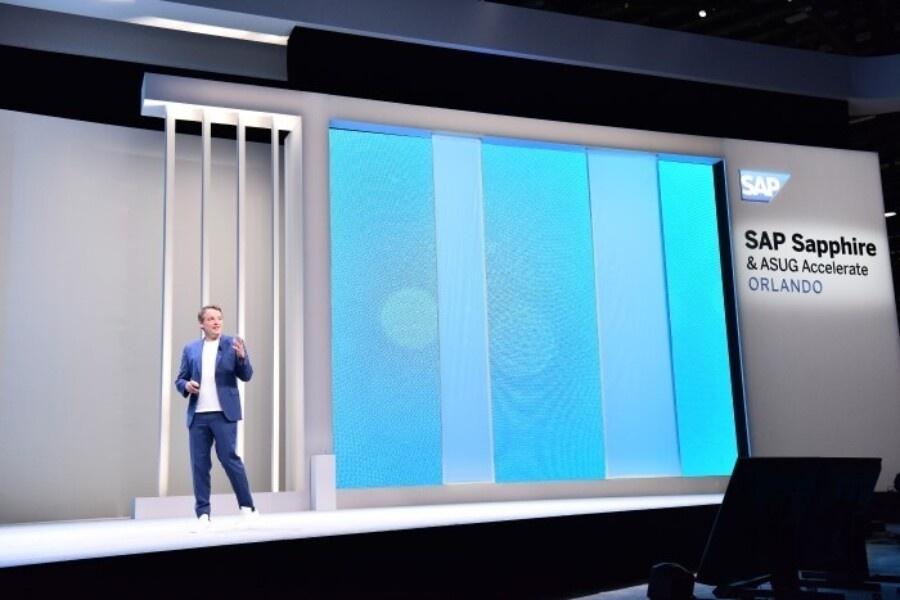SAP’s user conference, Sapphire, ran from June 3rd through the 5th in Orlando. 12,000 SAP customers and partners attended the event, and another 15,000 watched remotely.
SAP (NYSE: SAP) is the world’s largest provider of enterprise applications. The German software colossus has 27,000 customers and 300 million users that rely on their software.
The biggest message coming out of Sapphire is that SAP has gone all-in on AI. SAP has embedded an AI copilot – Joule – throughout Its enterprise portfolio. 27,000 customers are regularly using SAP Business AI, either as part of the SAP business flow or they have used SAP’s Business Technology Platform to create a custom AI solution. Based on the announcements at Sapphire, that number is poised to get far bigger, very quickly.
The RISE with SAP offering includes an AI-powered cloud ERP that’s managed and optimized by SAP. This is SAP’s feature-rich private Cloud offering. SAP’s GROW offering does the same for small and mid-sized companies. This is a public Cloud solution.
The company has already developed 50 use cases where AI can help its customers derive additional benefits from their solutions. When SAP refers to AI, it refers to generative AI based on large language models or AI based on machine learning. By the end of the year, the company will have roughly 100 use cases. Christian Klein, SAP’s CEO, said, “We are not adding use cases unless they add value.” This is not about establishing bragging rights. Each new use case has been vetted to ensure that customers can get real value.
Joule is a role-based user interface that understands the process a worker is engaged in and places in a workflow where users frequently need extra help. Joule allows users to get additional information or suggested resolutions to a problem with unprecedented ease.
This is a next-generation user interface analogous to Alexa or Siri. I might tell Alexa, for example, “Play the station Smooth Jazz!” In contrast, Joule is Business AI. If there was a heat wave in the southwest, a logistics manager might say, “Joule, show me every refrigerated truck shipment in Arizona today!” The manager would not be required to drill down through web page after web page and look at dense tabular data to get the answer.
In Joule, Mr. Klein asserts that 80% of the most common tasks can be infused with AI. Most of the new in-context GenAI solutions have been pre-trained on 200,000 pages of SAP’s training and technical documents. The Business AI also understands the SAP canonical data. These two things mean that while the GenAI responses are not 100% accurate, no GenAI solution is, they are far more reliable than the answers people get when using GenAI on the public web.
Further, when users do not follow the recommendations or note that the answer provided is not accurate, their feedback can lead to further training for the AI model.
SAP argues that its approach to GenAI is superior to the narrower AI use cases offered by best-of-breed application providers. An end-to-end process often cuts across applications. SAP uses its Business Technology Platform to manage end-to-end processes and consequently can create AI use cases in the gray spaces between applications.
The Customer Permission Conundrum
Most of the Joule use cases have been developed using SAP’s internal training data. These use cases generate good results without using customer data for training.
In other use cases, customer data can either improve the training or the training might be impossible without this data. For example, when GenAI is used to write job descriptions, aggregated anonymized customer data can improve the results. However, some customers believe giving SAP permission to use their data could benefit their rivals. For example, an airline that develops a job description for a mechanic – and has used its own data to improve the job description – might not see any value in allowing its competitors to derive value from its work.
Thousands of customers have given SAP permission to use their data for training purposes, but many, maybe most, will never allow this.
AI Use Cases
SAP detailed AI use cases for code generation to create extensions to the ERP, giving managers insights for compensation-related discussions, and sales forecasting capabilities that can be used to predict the combinations of salespeople and products most likely to drive sales.
However, the supply chain use cases were perhaps the most interesting. The optimization and machine learning that already exist in supply chain applications are core to gaining value from these solutions. Nevertheless, Joule will further enhance SAP’s supply chain offerings.
All applications can have a garbage in, garbage out problem. AI can be used to improve the master data, such as finding SKUs that are most likely duplicates. It can improve the accuracy of the parameters used. For example, lead times are often set and then ignored. However, lead times can change over time. Machine learning can help detect and fix this critical parameter.
Supply chain planning is frequently subject to a black box problem—users don’t understand the recommended manufacturing or inventory plan arising from an optimization run. Skilled users can dig into the log data and figure out why a particular plan was generated, but most users cannot. If users don’t trust the answers, they don’t use the applications, and the application becomes expensive shelfware.
Now, a user can simply ask Joule, “why are service levels declining?” “In three seconds,” according to David Vallejo – the global head of digital supply chain at SAP – “Joule can provide a shockingly good answer. First of all, demand has increased. Secondly, we have a major constraint at this work center.”
Joule can even provide potential answers. In many instances, when there is a problem, there can be relatively few ways to deal with that problem. Joule can be told to do an optimization run around this confined set of scenarios and suggest the best answer.
SAP is also developing a logistics use case. Many carriers can’t provide advanced ship notices or other shipment data electronically. They show up with paper documents. These documents are read, and core information is keyed into a logistics application. But manual entry of data is prone to error. Optical character recognition has been used to help automate this problem. Optical character recognition uses automated data extraction to convert images of text into a machine-readable format. However, because the shipping documents can have highly variable formats, OCR can struggle to extract the pertinent data. SAP believes the combination of GenAI and OCR will greatly improve the reliability of the output.
In conclusion, every provider of enterprise applications is talking a great deal about AI. No other vendor, however, has placed as big a bet on GenAI as SAP. SAP is all-in on AI.
Read the full article here










